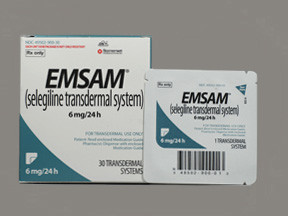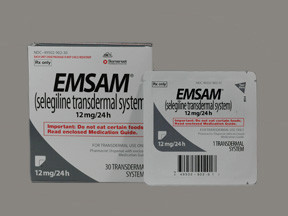SELEGILINE - TRANSDERMAL
PHONETIC PRONUNCIATION: (seh-LEDGE-uh-leen)
COMMON BRAND NAME(S): Emsam
GENERIC NAME(S): selegiline
Uses
USES: Selegiline is an antidepressant (monoamine oxidase inhibitor) that treats depression by restoring the balance of certain natural substances (neurotransmitters) in the brain. Selegiline can improve your mood and feelings of well-being. This medication is a patch for use on the skin.
How to use SELEGILINE - TRANSDERMAL
HOW TO USE: Read the Medication Guide available from your pharmacist before you start using selegiline and each time you get a refill. If you have any questions, consult your doctor or pharmacist. Follow the package instructions for using this medication. Make sure you understand how to apply a new patch and dispose of the used product. Do not cut the patch into smaller sizes. Do not use the patch if it appears broken, cut or damaged. If you have any questions, consult your doctor or pharmacist. Before applying the patch, wash the area you will be using for the patch gently and thoroughly with soap and water. Rinse and dry with a clean dry towel. Do not apply the patch to hairy/oily/red/cut/irritated/broken or scarred/calloused skin. Remove the patch from the foil pouch and apply as directed by the manufacturer. Apply one patch to an area of clean dry skin on the upper body (torso), upper thigh, or on the outside of the upper arm where it will not be rubbed by tight clothing. Change the patch daily at about the same time each day. Apply the patch to a different area on your body each time to avoid irritation. If your patch falls off, apply a new patch to a new area and continue on your same schedule. Be sure to remove the old patch, fold it in half so it sticks to itself, and throw it away out of the reach of children and pets. Do not touch the sticky side with your fingers. Wash your hands with soap and water after handling the patch. To reduce your risk of side effects, your doctor may start you at a low dose and gradually increase your dose. Usually, your daily dose will not be more than 12 milligrams. Once your condition improves and you are better for a while, your doctor may work with you to reduce your regular dose. Follow your doctor's instructions carefully. Do not apply more patches or leave the patch on for longer than prescribed. Your condition will not improve any faster and your risk of side effects will increase. Use this medication regularly in order to get the most benefit from it. To help you remember, use it at the same time each day. It may take several weeks for the full benefits of this medication to be noticed. Do not stop using this medication without consulting your doctor. Inform your doctor if your condition persists or worsens.
Side Effects
Precautions
Interactions
Overdose
Images
Reviews
Faq for SELEGILINE - TRANSDERMAL
Selegiline transdermal is a medication that is applied to the skin to treat symptoms of Parkinson's disease.
Selegiline transdermal works by increasing levels of dopamine in the brain, which helps to improve motor function and reduce symptoms of Parkinson's disease.
Selegiline transdermal comes in the form of a patch that is applied to clean, dry skin on the upper torso, upper thigh, or outer surface of the upper arm. It should not be applied to skin that is irritated or damaged.
The selegiline transdermal patch should be changed every 24 hours. It is important to remove the old patch before applying a new one to a different location on the skin.
Common side effects of selegiline transdermal may include skin irritation at the application site, dizziness, headache, and nausea. Serious side effects are rare but may include hallucinations, confusion, and severe allergic reactions.
Selegiline transdermal may interact with other medications, so it is important to inform your doctor about all medications you are taking, including over-the-counter drugs and supplements.
It may take several weeks for selegiline transdermal to start working fully. It is important to continue using the medication as directed, even if you do not immediately notice improvement in your symptoms.
Selegiline transdermal should be used during pregnancy only if clearly needed and under the supervision of a healthcare professional. It is not recommended to use selegiline transdermal while breastfeeding, as it may pass into breast milk.
If you accidentally overdose on selegiline transdermal, seek immediate medical attention. Symptoms of overdose may include severe headache, confusion, hallucinations, and irregular heartbeat.
Warning
WARNING: Antidepressant medications are used to treat a variety of conditions, including depression and other mental/mood disorders. These medications can help prevent suicidal thoughts/attempts and provide other important benefits. However, studies have shown that a small number of people (especially people younger than 25) who take antidepressants for any condition may experience worsening depression, other mental/mood symptoms, or suicidal thoughts/attempts. Therefore, it is very important to talk with the doctor about the risks and benefits of antidepressant medication (especially for people younger than 25), even if treatment is not for a mental/mood condition. Tell the doctor right away if you notice worsening depression/other psychiatric conditions, unusual behavior changes (including possible suicidal thoughts/attempts), or other mental/mood changes (including new/worsening anxiety, panic attacks, trouble sleeping, irritability, hostile/angry feelings, impulsive actions, severe restlessness, very rapid speech). Be especially watchful for these symptoms when a new antidepressant is started or when the dose is changed. This medication must not be used in children younger than 12 years due to an increased risk of serious side effects (such as extremely high blood pressure). Also, this medication is not recommended for use in children between 12 and 17 years old. Studies have not shown it to work in children in this age group.
Disclaimer
IMPORTANT: HOW TO USE THIS INFORMATION: This is a summary and does NOT have all possible information about this product. This information does not assure that this product is safe, effective, or appropriate for you. This information is not individual medical advice and does not substitute for the advice of your health care professional. Always ask your health care professional for complete information about this product and your specific health needs.



No Reviews Yet